Main place of work and commuting time - statistics
Data extracted in September 2020
No update foreseen since data are based on an ad-hoc module.
Highlights
In 2019, almost 200 out of 370 million persons, aged 15 years and more, were in employment. The main place of work where employed persons carried out their main job before the COVID-19 pandemic, as well as the time they spent getting from home to work, i.e. the commuting time, varies across Member States.
This article is the third and last of a set of articles related to the topic "work organisation and working time arrangements" (ad hoc module of the Labour Force Survey conducted in 2019). It presents results for the European Union as a whole, for each of the 27 EU Member States as well as the United Kingdom, three EFTA countries (Iceland, Norway and Switzerland) and Turkey (one of the candidate countries). The first and the second articles related to the topic "work organisation and working time arrangements" deal with flexibility at work and job autonomy and pressure at work.
The main place of work and the commuting time before the COVID-19 pandemic differ across countries and are highly dependent on socio-demographic characteristics of the population, namely sex, age, educational attainment level and degree of urbanisation. Therefore, the relationship between, on the one hand, the main place of work and the commuting time, and on the other, the socio-demographic variables, is analysed in this article.
Full article
Four in five employed persons mainly worked at their employer's or own premises
Before the start of the COVID-19 pandemic, the vast majority of employed persons in the EU-27 mainly worked at their employer's or their own premises (79.0 % in 2019). By contrast, 9.5 % of workers in 2019 mostly worked at their clients' places, i.e. at premises or homes of clients, and 8.6 % at non-fixed or other kinds of places (e.g. vehicle). Only 2.9 % of employed persons worked mainly at home.
At country level, around 85 % of employed persons in Greece (85.1 %) and Hungary (85.0 %) usually worked at their employer's or their own premises in 2019. By contrast, only 66.2 % of workers in the Netherlands had this main place of work. However, the Netherlands (17.2 %) and Belgium (16.0 %) recorded the highest shares of workers mainly carrying out their job at clients' places. In comparison, less than 5 % of workers in Slovenia (4.5 %) and Greece (4.0 %) had their client's premises as their main place of work.
Luxembourg, Slovenia, Czechia, Romania, Austria, Spain, Greece, Lithuania, the Netherlands, Latvia, Croatia, Malta and Poland recorded more people working at non-fixed or other kinds of places than the EU average (being 8.6 %), with shares ranging from 8.7 % in Luxembourg to 13.4 % in Poland. Among the other EU Member States, the corresponding shares varied from 4.1 % in Denmark to 8.5 % in Estonia. On the other hand, the share of those working mainly at home ranged, across all 27 EU Member States, from 0.3 % in Bulgaria to 6.3 % in Slovenia.
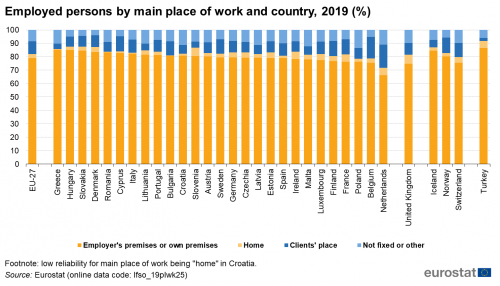
Main working place by sex, age, education and degree of urbanisation
In 2019, more women than men worked mainly at their employer's or their own premises: 87.4 % of women compared with 71.8 % of men. Nevertheless, this type of place of work was by far the most common for both sexes. For those working mainly at premises or homes of clients, the situation as regards gender was the opposite: this as the main place of work was more often reported by men (12.6 %) than women (6.0 %). The same holds for the non-fixed or other kinds of places: relatively more men (13.1 %) than women (3.2 %) worked mostly at non-fixed or other places.
Employed persons in the youngest age group had their employer's or own premises as their main place of work more often than the other age groups: 81.5 % of employed persons aged 15-34 reported this type of work place versus 78.9 % of those aged 35-49 and 76.8 % of those aged 50-74. On the other hand, relatively more senior workers (4.1 %) worked mainly at home than the young (1.9 %) and middle-aged (2.8 %) workers.
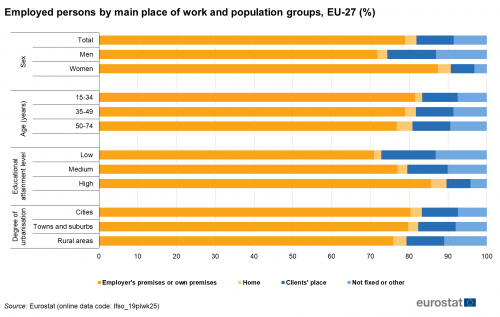
The higher the educational attainment level, the greater the chances that employed persons work mainly at the employer's or their own premises. In 2019, 85.5 % of workers with a high educational attainment level were in this position, compared with 71.0 % and 77.0 % of employed persons with a low and medium educational attainment level respectively. A similar pattern can be found for those working mainly at home albeit with lower shares (4.1 % for high, 2.5 % for medium and 1.8 % for low educational levels). The situation was the opposite for those working mainly at clients' places or at non-fixed or other places: workers having attained a high educational level (6.2 % for clients' places and 4.2 % for non-fixed or other places) reported these places of work less often than the workers having attained a low (14.0 % and 13.2 %) or medium educational level (10.4 % and 10.1 %).
The breakdown by degree of urbanisation shows some differences between, on one hand, employed persons living in rural areas, and on the other, those living in cities or in towns and suburbs. Indeed, 75.9 % of workers from rural areas had their employer's or their own premises as their main place of work versus 80.3 % and 79.7 % of workers from cities or towns and suburbs. Also, 11.0 % of workers from rural areas worked mainly at non-fixed or other places while only 7.4nbsp;% and 8.0nbsp;% of those living in cities or towns and suburbs did so.
Widest gap between men and women living in rural areas with low and medium education
The previous section concluded that women, workers having attained a high educational level and those living in cities displayed the highest shares of persons working mainly at their employer's or their own premises before the crisis linked to COVID-19. Crossing these three dimensions, it can been seen that whatever their educational attainment level and degree of urbanisation, women tend to work more often at the employer's or their own premises than men (see Figure 3). For example, in 2019, 89.1 % of women with a high educational attainment level and living in cities had this as their main place of work versus 82.3 % of their male counterparts.
People living in cities and having attained a high educational level corresponded with the smallest gender gap as regards to the share of persons working at the employer's or their own premises (89.1 % for women versus 82.3 % for men, with a gender gap of 6.8 percentage points (p.p.)). The gender gap was larger namely for those having attained a high educational level but living in rural areas (89.2 % for women and 78.5 % for men, showing a gender gap of 10.7 p.p.). The widest gender gaps, as regards the share of persons working at the employer's or their own premises, were found within the group of persons living in rural areas with a low or medium educational attainment level: these gaps were equal to 19.3 p.p. for those with a low education level (81.8 % for women versus 62.5 % for men) and 20.2 p.p. for those with a medium education level (85.9 % for women versus 65.8 % for men).
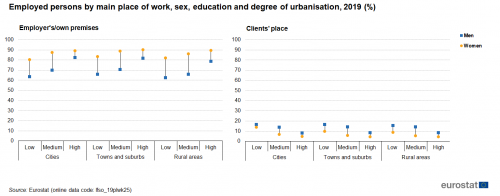
For employed persons working mainly at the premises or homes of clients, the situation is reversed. As described previously, more men than women worked mainly at the premises or homes of clients before the COVID-19 crisis. The smallest gender gap concerned people with low educational attainment level living in cities (gap of 2.5 p.p.: 16.4 % of men versus 13.9 % of women). By contrast, the largest gender gap was found for those having a medium educational attainment level and living in rural areas (gap of 8.9 p.p.: 14.0 % of men versus 5.2 % of women).
Two in five employed persons working mainly at their own or their employer's premises regularly work from home
In 2019, more than two in five employed persons in the EU, who worked mainly at their own or their employer's premises and regularly changed their location of work (at least once a week), worked from home on a regular basis; more precisely, 31.8 % of them sometimes worked from home and 10.7 % usually did. Consequently, almost three in five employed persons in the EU-27, who mainly worked at their own or their employer's premises and regularly changed their location of work (at least once a week), said that they never worked from home (57.5 %).
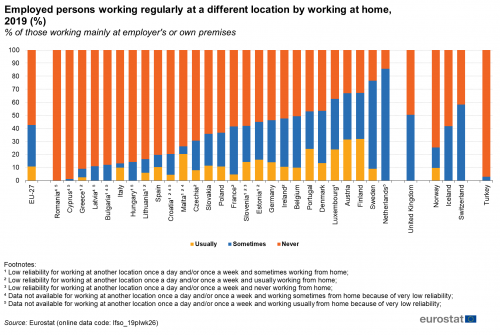
Finland recorded the highest share of people usually working from home (31.9 %) among the employed persons mainly working at their own or their employer's premises and regularly changing their main place of work, followed by Austria (31.4 %). In addition, the Netherlands and Sweden reflected the largest shares of people sometimes working from home (85.6 % and 67.4 % respectively).
Commuting time for majority of European workers is less than 30 minutes
Before the start of the COVID crisis, more than half of employed persons in the EU-27 travelled less than 30 minutes from home to work, i.e. commuted one-way and without any detours (61.3 % in 2019). In comparison, one in four travelled 30 minutes or more, but less than one hour (26.3 %), while less than one in ten workers had a commuting time of 60 minutes or more (8.1 %). Finally, only 4.3 % of employed persons did not need to travel at all in order to get to their main place of work.
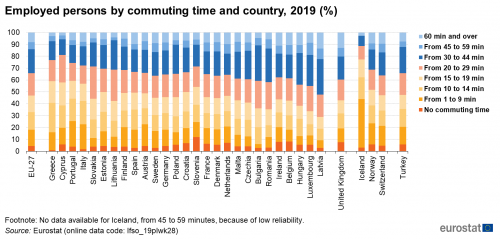
At country level, three in four workers in Greece (75.8 %) and Cyprus (75.5 %) had a one-way commuting time of less than 30 minutes. By contrast, only half of the workers in Luxembourg (49.4 %) and Latvia (44.9 %) were in this situation. These last two countries had the highest shares of workers with a commuting time of 30-59 minutes among the EU Member States (36.3 % and 38.8 % respectively). On the other hand, Cyprus (16.2 %) and Portugal (19.2 %) were the EU countries with the lowest shares of workers commuting one-way between 30 and 59 minutes. Regarding long commuting time, more than one in ten employed persons in Latvia (13.5 %), Ireland (11.2 %), Belgium (10.7 %) and Hungary (10.6 %) had to travel from home to work for 60 minutes or more.
Commuting time by population group
More women than men had a commuting time of less than 30 minutes from home to their main place of work in 2019, with 63.9 % of women compared with 59.0 % of men. For those with a time to travel to work of 30 minutes and more, the opposite was the case. Men were more likely to commute longer with 36.8 % compared with 31.6 % of women.

Employed persons in the junior and middle aged groups (15-34 and 35-49 years respectively) had a longer commuting time than their counterparts aged 50-74. Around 35 % of the two younger age groups commuted 30 minutes or more (36.3 % and 35.1 % respectively) in comparison with 31.8 % of the oldest age group. As regards the commuting time of less than half an hour, there were almost no differences between the age groups.
The higher the educational attainment level of employed persons, the longer the commuting time. A larger share of workers with low educational level had a commuting time of less than 30 minutes (68.6 %), compared with those with a high educational level (54.7 %). People with a medium educational attainment level were in-between with 63.6 %. Furthermore, while 40.4 % of commuters with a high educational attainment level had to travel 30 minutes or more to work, this accounted for only 27.7 % of the workers with a low educational level.
Workers living in cities had a longer commuting time than those living in areas with a lower degree of urbanisation. Around 30 % of employed persons living in towns or suburbs (30.4 %) and rural areas (30.5 %) had a commuting time of 30 minutes or more. This in comparison with 40.3 % of employed persons living in cities. Furthermore, 65.8 % and 63.6 % of employed persons living in towns/suburbs and rural areas respectively, had a commuting time of less than half an hour. Employed persons living in cities were in the same position with 55.9 %.
Employed persons in Latvia had the longest average commuting time
In 2019, persons in employment in the EU had an average commuting time of 25 minutes. Employed persons in Latvia had the longest commuting time with 33 minutes, followed by Hungary and Luxembourg (both 29 minutes). The United Kingdom also recorded a long average commuting time (30 minutes).
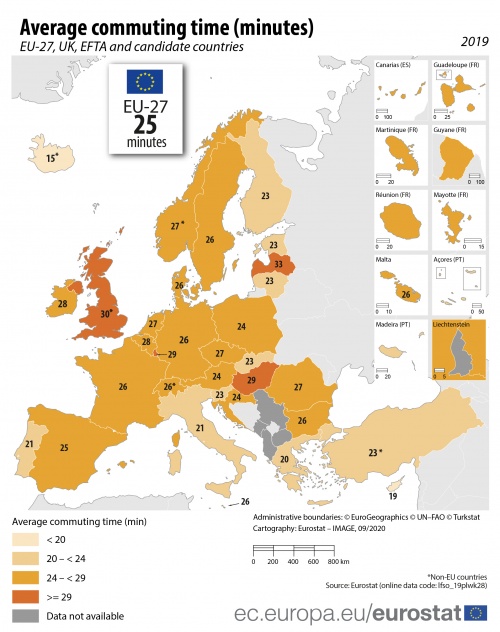
The largest share of countries had a commuting time between 24 minutes and 28 minutes (17 countries). This group of countries included (in decreasing order) Belgium and Ireland (both with an average commuting time of 28 minutes); Czechia, the Netherlands, Romania, as well as Norway (all 27 minutes); Bulgaria, Denmark, Germany, France, Malta, Sweden, as well as Switzerland (all 26 minutes); Spain was the only country with an average commuting time of 25 minutes. In addition, Croatia, Austria and Poland were also part of this group with an average commuting time of 24 minutes.
The following group, corresponding to an average commuting time of 20 to 23 minutes, consisted of 9 countries, including Estonia, Lithuania, Slovenia, Slovakia, Finland and Turkey (all with an average commuting time of 23 minutes). Also Italy, Portugal (both 21 minutes) and Greece (20 minutes) were part of this group. Finally, workers in Cyprus, as well as Iceland had the shortest average commuting time with 19 and 15 minutes respectively.
Having children partly affects average commuting time
At first sight, the overall tendency is that men had a longer average commuting time than women before the corona-virus crisis. This is independent of the fact that a person lived alone, in a couple or in another type of household (i.e. household type).
The majority of countries for which data is available, show that women living alone without children had a slightly longer commuting time than single women with children in the household in 2019. The most pronounced examples were recorded in Croatia (26 versus 17 minutes), Germany (26 versus 22 minutes), Latvia (31 versus 27 minutes) and Greece (22 versus 18 minutes). A similar situation for single men is only found in six countries, namely Latvia, Hungary, the Netherlands, Czechia, Romania and Spain. In Germany, Austria, Estonia and Italy there were no differences at all. By contrast, seven countries recorded a longer average commuting time for single men living with children than for single men living without children. Here, the most striking difference is recorded in Ireland (32 versus 27 minutes) and Poland (30 versus 24 minutes).

Looking at men and women living in a couple, the link between the presence of children in the household and the commuting time is less pronounced than for the single persons. However, noteworthy differences between couples with and without children can be found in Ireland and Hungary. First, men and women in Ireland with children had, on average, a longer commuting time than those without children, i.e. 32 versus 29 minutes for men and 27 versus 25 minutes for women respectively. On the other hand, women in Hungary without children commuted longer than those with children, with 28 and 24 minutes respectively. Predominant differences can nevertheless be found between men and women with children. For example, men in Hungary living in a couple with children commuted on average seven minutes longer than their female counterparts (31 versus 24 minutes). A similar situation is recorded for the Netherlands (30 minutes for men compared with 23 minutes for women).
Men and women living in another type of household without children were more or less in the same position as their counterparts who lived in a couple. However, differences between women with and without children were more pronounced. This was mainly highlighted in Ireland and Latvia, where women living in another type of household without children, commuted on average four and three minutes longer than women with children (26 compared with 22 minutes in Ireland; 34 compared with 31 minutes in Latvia).
Workers living in cities have the longest commuting time
In 2019, employed persons living in cities spent more time on commuting between home and work than those living in towns, suburbs or rural areas. Workers living in cities in the EU-27, recorded an average commuting time of 27 minutes, compared with 24 minutes spent by those living in towns, suburbs or rural areas. This is the main pattern across countries in the EU, but there are some exceptions, including Luxembourg, Malta, Estonia, Slovakia, Slovenia, Cyprus and Belgium.
Employed persons in Luxembourg who lived in suburbs, towns or rural areas, had a longer commuting time than those living in cities: the travel from home to work took on average 31 minutes for those living in suburbs/towns and rural areas compared with 24 minutes for those living in cities. In Malta, the average commuting time decreased with increase in degree of urbanisation. Workers living in rural areas commuted 31 minutes in one direction, in comparison with 27 minutes (towns and suburbs) and 24 minutes (cities) for employed persons living in the other areas. Workers living in the rural areas of Estonia, Slovakia, Slovenia and Cyprus, also travelled on average a few minutes longer to their main job than those living in towns, suburbs and cities. For example, in Cyprus, employed persons living in rural areas commuted 23 minutes in comparison with those living in areas with a higher degree of urbanisation, i.e. 18 and 19 minutes for employed persons living towns/suburbs and cities respectively. Finally, for commuters in Belgium, the average time spent travelling from home to work was almost unaffected by the area someone was living in. Persons living in cities, towns and suburbs had an average commuting time of 28 minutes compared with 29 minutes for those living in rural areas.
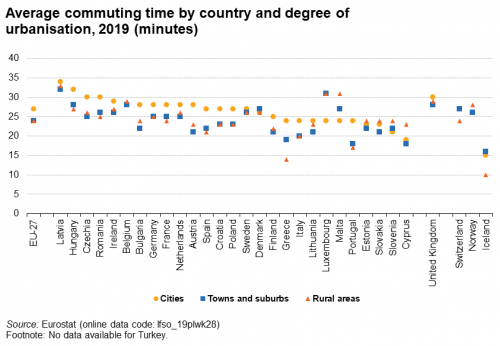
Source data for tables and graphs
Data sources
Source: The European Union Labour Force Survey (EU-LFS) is the largest European household sample survey providing quarterly and annual results on labour participation of people aged 15 and over as well as on persons outside the labour force. It covers residents in private households. Conscripts in military or community service are not included in the results. The EU-LFS is based on the same target populations and uses the same definitions in all countries, which means that the results are comparable between the countries. The EU-LFS is an important source of information about the situation and trends in the national and EU labour markets. Each quarter around 1.8 million interviews are conducted throughout the participating countries to obtain statistical information for some 100 variables. Due to the diversity of information and the large sample size, the EU-LFS is also an important source for other European statistics like Education statistics or Regional statistics.
Reference period and coverage: Results are obtained during the whole year (annually or quarterly). More detailed information can be found in the assessment report.
Target population: the target population of this ad-hoc module is persons in employment aged 15 years and older.
European aggregates: EU and EU-27 refer to the totality of the EU of 27 Member States. If data are unavailable for a country, the calculation of the corresponding aggregates takes into account the data for the same country for the most recent period available. Such cases are indicated.
Definition of employment: The concepts and definitions used in the survey follow the guidelines of the International Labour Organisation. Employment covers persons aged 15 years and over (16 and over in Spain and Italy, 15-74 years in Estonia, Latvia, Hungary, Finland, Sweden, Norway and Denmark, and 16-74 years in Iceland), living in private households, who during the reference week performed work, even for just one hour, for pay, profit or family gain, or were not at work but had a job or business from which they were temporarily absent, for example because of illness, holidays, industrial dispute or education and training.
Definition of a child: Children refer to persons aged less than 15 years.
Educational attainment level: The level of education refers to the educational attainment level, i.e. the highest level of education successfully completed. Low level of education refers to ISCED levels 0-2 (less than primary, primary and lower secondary education), medium level refers to ISCD levels 3 and 4 (upper secondary and post-secondary non-tertiary education) and high level of education refers to ISCED levels 5-8 (tertiary education).
Context
The EU has a longstanding commitment to support the principles on secure and adaptable employment, work-life balance and well adapted work environment. This is evidenced by the European employment strategy, the employment guidelines and the European Pillar of Social Rights which express the need for greater adaptability of both enterprises and workers in Europe. Those EU initiatives highlight the need to collect data on the application of new practices in work organisation and working time arrangements and the experiences of workers with those practices and arrangements at European level. In order to monitor the progress in this area, the implementation of the European Union Labour Force Survey (EU-LFS) 2019 module on work organisation and working time arrangements is of high importance.
In the context of investigating the balance between work and family life of the European population, employment statistics are of high importance. Employment statistics are at the heart of many EU policies. The European employment strategy (EES) was launched at the Luxembourg jobs summit in November 1997 and was revamped in 2005 to align the EU’s employment strategy more closely to a set of revised Lisbon objectives, and in July 2008, employment policy guidelines for the period 2008–2010 were updated. In March 2010, the European Commission launched the Europe 2020 strategy for smart, sustainable and inclusive growth; this was formally adopted by the European Council in June 2010. The European Council agreed on five headline targets, the first being to raise the employment rate for women and men aged 20 to 64 years old to 75 % by 2020. EU Member States may set their own national targets in the light of these headline targets and draw up national reform programmes that include the actions they aim to undertake in order to implement the strategy.
The implementation of the strategy might be achieved, at least in part, through the promotion of flexible working conditions — for example, part-time work or work from home — which are thought to stimulate labour participation. Among others, initiatives that may encourage more people to enter the labour market include improvements in the availability of childcare facilities, providing more opportunities for lifelong learning, or facilitating job mobility. Central to this theme is the issue of ‘flexicurity’: policies that simultaneously address the flexibility of labour markets, work organisation and labour relations, while taking into account the reconciliation of work and private life, employment security and social protection. In line with the Europe 2020 strategy, the EES encourages measures to help meet three headline targets by 2020, namely, for:
• 75 % of people aged 20 to 64 to be in work;
• rates of early school leaving to be reduced below 10 %, and for at least 40 % of 30 to 34-year-olds to have completed tertiary education;
• at least 20 million fewer people to be in or at-risk-of-poverty and social exclusion.
Employment and social policies are also the main fields of interest of the European Pillar of Social Rights, which is about delivering new and more effective rights for citizens. It has three main categories: (1) Equal opportunities and access to the labour market; (2) Fair working conditions; (3) Social protection and inclusion.
In particular, today's more flexible working arrangements provide new job opportunities especially for the young but can potentially give rise to new precariousness and inequalities.
Direct access to